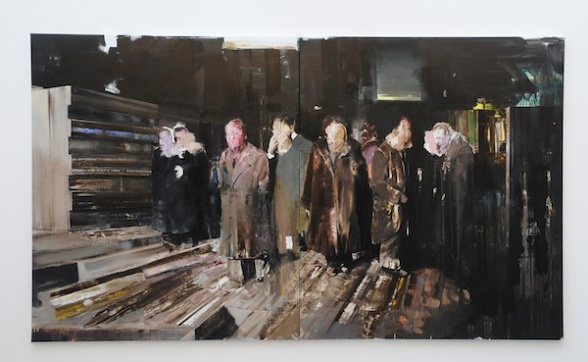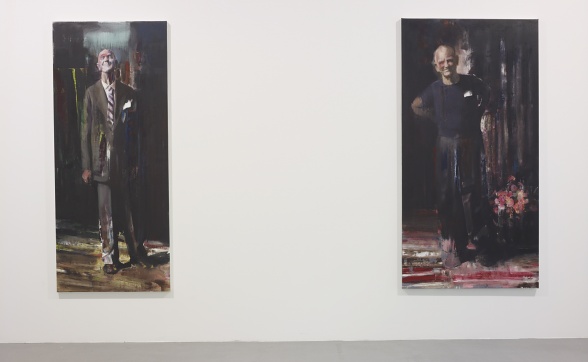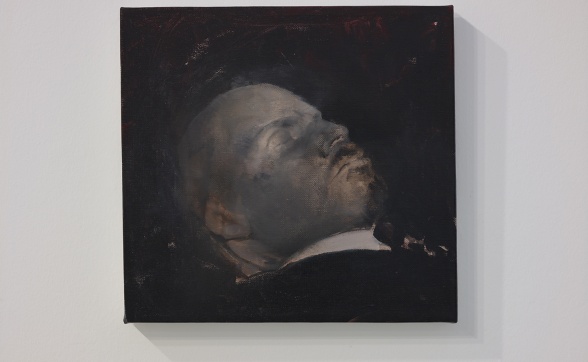Adrian Ghenie

Adrian Ghenie, Nickel Odeon (installation view), 2008

Adrian Ghenie, Nickel Odeon (installation view), 2008

Adrian Ghenie, Nickel Odeon (installation view), 2008

Adrian Ghenie, Nickel Odeon (installation view), 2008
Adrian Ghenie, Nickel Odeon (installation view), 2008
Adrian Ghenie (b. 1977, Baia Mare) plunders visual history via disparates avenues - archives, history books, cinema, painting, YouTube and Google - to build his dense, multi-layered paintings. His preparations are intriguing in their ebb and flow between fact and fabrication. Once images are selected from different modes of representation, Ghenie creates collages with printed images that are overworked and embellished in paint. Sometimes he turns stills into cardboard models, creating a kind off mini film set, tangible, with shifting light and relative scale.
The impact of early cinema underpins much of Ghenie's recent work. Until the arrival of the moving image in the 1890s, the world formulated a collective understanding of actuality from text and still representations. The advent of cinema changed public perceptions of reality, the collective subconscious and individual memory. Cinematic imagery and the transferral of moving images to memory interfere with our understanding of history in a confusing way. Once such manifestations enter the mind, there’s no controlling where they end up: imaginings, dreams, memories, sounds, read texts and watched images elide in some unconscious realm that fuses all. Just dissect the origins of the image that comes to mind when you recall the assassination of JFK.
Cinema’s aesthetic preoccupies Ghenie, particularly the moment cinema developed its own unique qualities: when scenes were created, seen and understood as nothing but filmic – movement, light, structure, genre, and moments repeated in different productions to the point of cliché that could not be separated from that medium, just as the surface and qualities of a Caravaggio can only really exist in paint.
The pie-fight, the zenith of slapstick, was the subject of Nickel Odeon (2008) inspired by perhaps the longest food-fuelled conflict in cinematic history in Blake Edwards’ The Great Race (1965). Ultimately appropriated from a freeze-framed clip of a Three Stooges movie, the still image had for Ghenie a ‘purity’ that aligned it with cinema alone. The moment, the sentiment, the comedy and function, would not be possible or believable in any other form. To prove his thesis he transposed it into paint, and, in order to unravel its veracity, merged it with documentary photographs of a state-organised mass humiliation – elderly jews forced to clean pavements with toothbrushes. There was a tension between the image presented and the subjects portrayed, between recognition of a popular cinematic moment and the vague awareness of a devastating historical act.
His diptych Laurel and Hardy, 2008 turned another inherently cinematic construct into painting. Its characters became instantly recognisable through attribute and gesture rather than plot or character: underweight, overweight, hair, moustache and hat – the modern equivalent of a saint or icon in a medieval painting. Merged with one of Velasquez’s courtroom buffoon paintings, the comedians arrived not from a classic film, but from one of their last, private, appearances, both shadows of their former shelves after serious illness. Rejecting a depiction of them in their classical guise, Ghenie further pondered the construction of memory through the visual and the creative of contemporary cliché.
Adrian Ghenie at Liverpool Biennial 2008
Nickel Odeon, 2008
Oil and acrylic on canvas,
Commissioned by Liverpool Biennial 2008
Exhibited at Tate Liverpool
Supported by
Calouste Gulbenkian Foundation
Liverpool Biennial
55 New Bird Street
Liverpool L1 0BW
- T +44 (0)151 709 7444
- info@biennial.com
Liverpool Biennial is funded by
Founding Supporter
James Moores